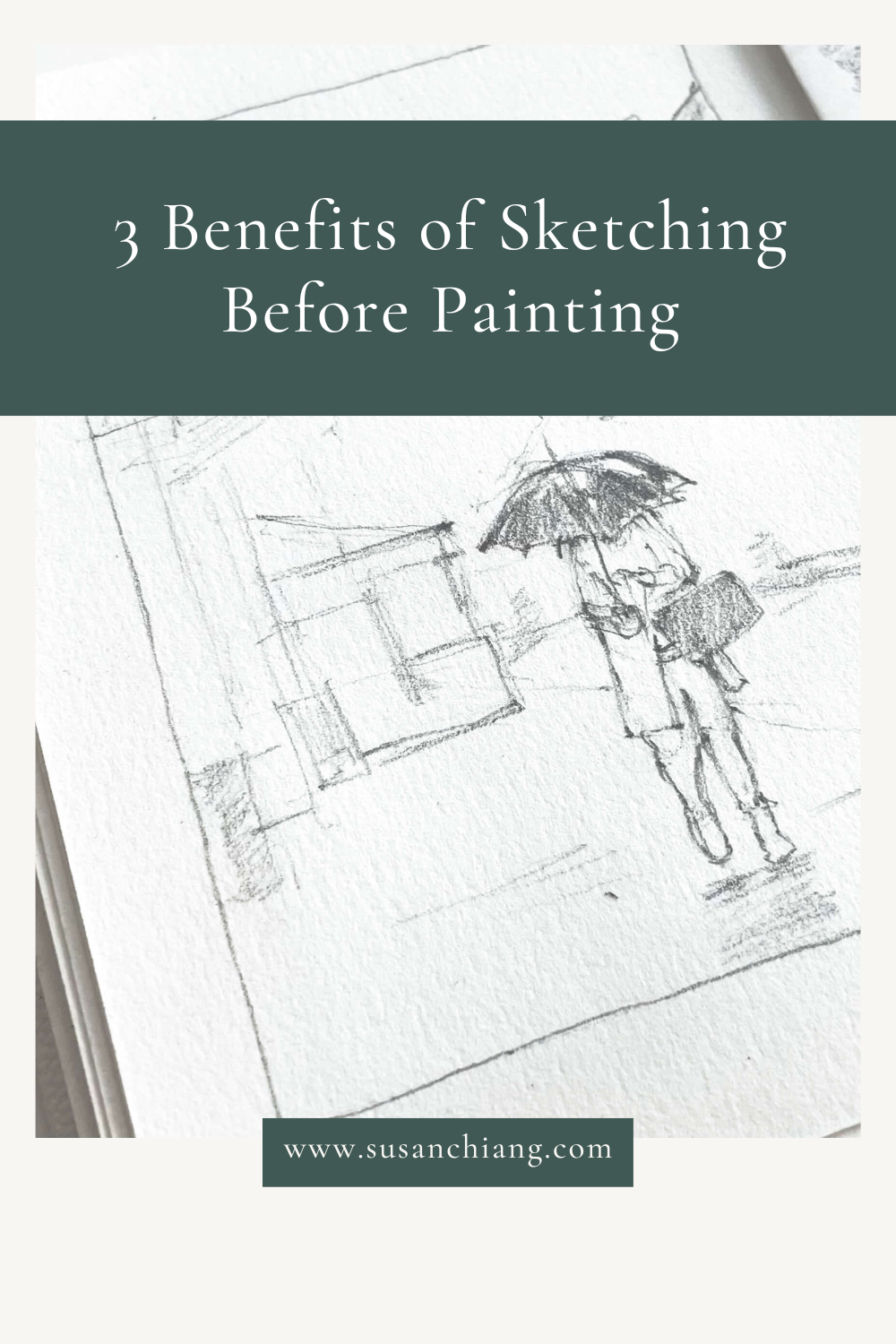3 Benefits of Sketching Before Painting
Do you need to know how to draw in order to paint? I can see this from both sides, but my answer would be ‘no’. In my opinion, you don’t need to know how to draw in order to paint. You especially don’t need to draw well in order to paint. Sometimes I draw first, then paint. Sometimes I simply sketch a few guidelines before paintings. And sometimes, I just paint.
However, I do think the ability to draw, even just a rough sketch, is helpful.
To sketch or not to sketch?
Before I get into the benefits, you might be wondering when I decide to do a sketch before painting. Assuming this applies to all paintings done using a visual reference, whether it’s a photograph or a real life, I will typically sketch under the following circumstances:
I feel unsure about the composition on the page or how I want to frame the image
The reference contains architectural elements or human figures that have more complex scale and proportions (compared to an apple, for example)
The values (light and darks) feel tricky and I want to use graphite to work through them first
And sometimes, I just feel more confident putting pencil down on paper first!
To sketch or not to sketch…on the watercolor paper?
The second part of this question is whether I lay down a sketch directly on the watercolor paper or not? This depends on:
How much of a guideline I want to have before painting
If I want to locate major elements like a horizon line or mountain ridge prior to painting
If the focus is a human or animal figure and I want to make sure proportions are correct
That being said, I found that some of the pencil lines will slowly disappear as water and paint are applied and some will not. It’s not a guarantee that the sketch will always remain there as a guide. But having had it before starting still helps. The act of putting it on paper and seeing it there creates a certain muscle memory that I can draw upon while painting.
The Benefits of Sketching
For the purposes of this post, I’m going to be talking directly about the benefits of doing an independent sketch (which you could also call a drawing study) of the reference photo prior to painting, separate from the painting and not on the watercolor paper.
1. Proportions + Layout
The main reason doing a sketch helps me is with working out proportions and overall layout.
Using a pencil to translate what I see from my reference onto the sheet of paper I’m working on is an exercise in scaling what I see onto a physical piece of paper. I don’t always get it right the first time, so doing this in pencil helps!
Tip: If you are sketching, sketch at the same scale you will be painting in. In other words, sketch on the same size paper as you plan to watercolor on. This helps practice how I am going to lay out the painting on the piece of paper.
Of course, this really works best when you’re doing something small like in a sketchbook or on a manageable sized piece of paper. (Can you imagine doing a full sheet size sheet sketch?!)
When it comes to human figures, animals, or architectural elements, doing a sketch will help me work through tricky proportions of these elements. I treat it like a practice session or run-through. It can be difficult for me to get proportions of people correct the first time (or sixth), so doing pencil sketches can show me where I might be over or underestimating while sketching - that way I can remember to take note while painting later on. The act of erasing and redrawing is really helpful - to me it’s not making a mistake, it’s learning and practice.
2. Details & Decisions
While I’m busy figuring out proportions and layout, I’m also sketching form, light, and shadows. I don’t sketch every detail, in fact, I don’t sketch many details at all - except for the important ones. The ones that I want to paint, the ones that I want the eye to focus on.
And while I’m sketching and honing in on the details that I want to capture later with paint, I’m also making decisions. Decisions about what details to include, but just as important, what details I want to leave out.
If I can “omit” the detail in the sketch, and it’s still successful, then I know that I can render it softly or loosely in the painting as well.
What I am also thinking about as I sketch is what technique or approach I might use when I paint.
Will this be wet-on-wet or wet-on-dry?
What order should I paint this in?
Should I use masking fluid?
There are no right or wrong answers and I never know how a painting will go, but the sketch allows me to slow down, observe, and ponder my approach. It’s an active way of planning out my process mentally, while keeping in mind that anything could happen when water gets involved!
3. Studying Value
You’ve likely heard of value sketches that are done as a quick study to figure out values. These are done as thumbnails, which are small but impactful. Having a good grasp of values and contrast really makes paintings pop. While I have not quite incorporated thumbnail sketches into my regular practice, I do find that noticing values and focusing on them while I do a sketch prepares me for painting.
Putting It Into Practice
If you feel like a certain element of your reference is going to be tricky when you paint, working it out through a pencil sketch first might be helpful - even if its not the whole picture and just a section of it.
If you’d like to see the process of one of my practice sketches done prior to painting, you can check out the YouTube video below:
For this rainy day scene, my intention was to understand the overall layout and how the figure was positioned within it, as well as to practice the figure itself. The figure has no head and is walking, something that I found to be tricky for me when it came to proportions. Drawing it out helped me practice.
The drawing isn’t a final drawing - it’s far from it. But it’s a study that helps me learn and practice and that’s really why I think that sketching can be beneficial. It’s not about producing a beautiful graphite piece.
It’s a way for me to figure some things out using a controlled medium before moving onto capturing it using a less controlled medium!
I hope you found something helpful from this post today. I’d love to know if you have further questions when it comes to drawing for watercolors. Let me know in the comments below.
As always, thank you for reading!
Susan

